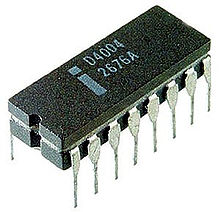Integrated circuits were made for a single specific purpose, but with the release of the Intel 4004 in 1971 by the Intel Corporation, the fourth generation of computing began. (Without the developments and innovations of this generation we would not have the fifth generation devices we now use.)
Courtesy of es.wikipedia.org
The Intel 4004 was the first commercially available microprocessor. Integrated circuits were reduced in size and many more components were added to each chip. Large scale integration (LSI) allowed hundreds of components to fit on to one chip. Very large scale integration (VLSI) allowed hundreds of thousands of components on to a single chip, and Ultra-large scale integration (ULSI) could fit millions of components on to a chip. The Intel 4004, for the first time, allowed all of the components of a computer; the central processing unit (CPU), input and output controls, and memory to be placed on one microprocessor. Microprocessors could be programmed for a variety purposes, rather than the old system of creating each IC for a purpose. These innovations allowed computers to become smaller in physical size, more powerful, efficient and cheaper. This was the beginning of personal computing.
The first consumer mini computers available to the non-technical public (like me) were word processors, spreadsheet programs, and the best original video gaming system ever Atari***.
Courtesy http://atariace.com/atari/
The Apple II, the first personal computer, built by Steve Jobs and Steve Wozniak in 1976 in a California garage. It was introduced to the public in 1977 at the West Coast Computer Faire. The cost was about $1,300 (about $5,000 today)
Courtesy of http://www.extremetech.com/computing/92640-ibm-personal-computer-its-30-year-legacy-slideshow
In 1981 IBM released its new line of personal computers at the Waldorf Astoria in New York City. The cost was $3,000 (about $8,000 today).
Courtesy of http://content.time.com/time/covers/0,16641,19830103,00.html
In 1982 TIME magazine’s “Man of the Year” cover went to the computer.
Courtesy of www.maximumpc.com
The first Macintosh computer with Graphic User Interface. (Ok, so technically it’s the Fifth Generation of computers.)
Glossary
Microprocessor – an integrated circuit (chip) that contains all of the components that a computer needs to function.
*** Disclaimer – this is purely my opinion about Atari. I am not a very technically savvy person, I am sure newer systems are “better”. However, Atari was my first system and will always hold a special place in my heart.

















